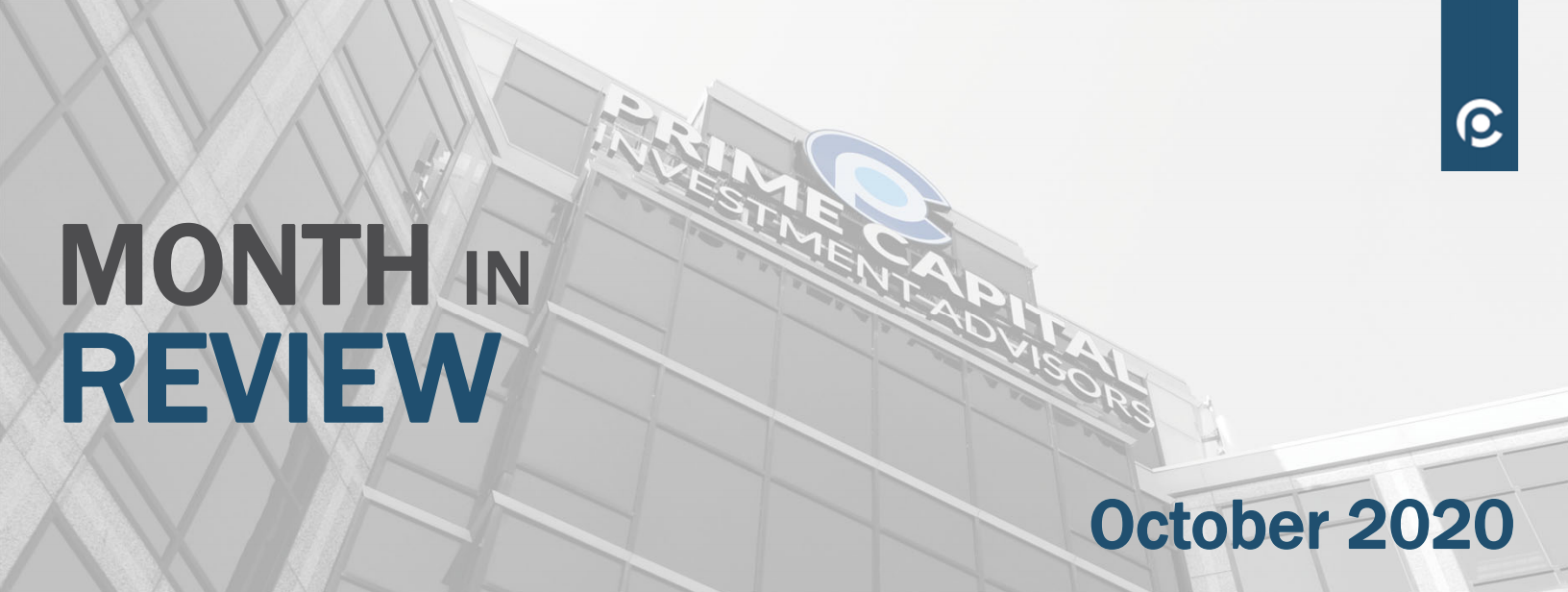The month of December initially began with traders pricing in a new covid-19 variant’s impact (omicron variant) on markets, but eventually shook off their concerns and turned their attention back to the Federal Reserve.
Month-in-Review: November 2021
Equities, especially international, plummeted for the month of September as the delta variant continued to work its way through populations and a new variant threatens the globe.
Month-in-Review: October 2021
Risk assets hit a speed bump. September ended deeply in the red for risk assets as global growth concerns began to weigh on the market. September is the first negative month since January and the worst month since March of 2020.
Month-in-Review: September 2021
Risk assets hit a speed bump. September ended deeply in the red for risk assets as global growth concerns began to weigh on the market. September is the first negative month since January and the worst month since March of 2020.
Month-in-Review: August 2021
Quick Takes
● Steady ascent. Despite higher COVID cases, rising geopolitical risks, mounting inflation fears, the looming Fed tapering, and waning economic growth, stocks continued their steady ascent with the S&P 500 closing August just below its all-time high.
● Delta damage. With Delta progressively spreading throughout the month, August saw a pullback in consumer activity, with notable declines in visits to Gyms, Grocery Stores, Restaurants, and Retailers. Air passenger traffic also rolled over in August after nearing pre-pandemic levels in June and July.
● Earnings exploding. With less than a handful of companies left to report earnings for the second quarter of 2021, data from FactSet shows the reported year-over-year growth in earnings is 91%–the highest growth since the fourth quarter of 2009.
● Expectations eroding. In the first two quarters of the year, economic results were consistently exceeding expectations. Since the beginning of July, and gaining downside momentum in August, a reversal of this dynamic has resulted in the vast majority of economic data now falling short of expectations.
Asset Class Performance
Returns for most major asset classes were relatively muted in August as U.S. and International Equities were up a bit, while U.S. and International Bonds declined slightly. Bonds are the only asset classes still negative for the year.

Stocks set records despite mixed economics and delta variant
August, traditionally a tepid month for stocks, ended on a high note with the S&P 500 closing at 4,522.68, up from July’s close of 4,395.26 and now the seventh consecutive month of gains. The S&P is now up a healthy +20.41% for 2021. Domestic equities weren’t the only ones to rise during August, European equities rose +1.98% for the month as did Japanese equities, up +2.95% for August. While markets were optimistic, some of the economic releases for the month painted a more mixed picture. On a positive note, CPI metrics came in largely in-line with expectations, which is more consistent with the Fed’s narrative of transitory inflation. Regardless, consumers are beginning to feel the pressures of rising prices and it weighted on Consumer Confidence. The University of Michigan’s Sentiment survey reached its lowest level since 2013 at 70.3. Manufacturing data also retracted, with ISM’s gauge of factory activity falling for a second month in a row, illustrating that supply chain bottlenecks and difficulty hiring labor, especially skilled labor, is still prevalent. Consumers have been hesitant to return to work as the delta variant spread has increased over the summer months, as illustrated in the chart below.
 Additionally, the fear of mask mandates and lockdowns returning has curbed consumer spending which fell to +0.3%for the month of July, missing expectations of +0.4%, and well below the prior month’s release of +1.1%. The miss on Consumer Spending came from softer than expected retail goods and automobiles, but service spending increased. If consumer spending continues to soften into the second half of the year, it could lead to stagnating the economic recovery. Despite consumers pessimism, Incomes surged +1.1%, crushing expectations of +0.3%. The advance was due to Child Tax Credit payments, which more than offset a decline in unemployment benefits, which have been tapering off in recent months as the economic recovery progresses. Overall, consumers remain in one of the best financial standpoints in history. Consumers aren’t alone, corporations are posting some of their strongest earnings in history. As earnings season wound down at the end of August, S&P 500 constituents posted a revenue surprise of 4.9% in aggregate,
Additionally, the fear of mask mandates and lockdowns returning has curbed consumer spending which fell to +0.3%for the month of July, missing expectations of +0.4%, and well below the prior month’s release of +1.1%. The miss on Consumer Spending came from softer than expected retail goods and automobiles, but service spending increased. If consumer spending continues to soften into the second half of the year, it could lead to stagnating the economic recovery. Despite consumers pessimism, Incomes surged +1.1%, crushing expectations of +0.3%. The advance was due to Child Tax Credit payments, which more than offset a decline in unemployment benefits, which have been tapering off in recent months as the economic recovery progresses. Overall, consumers remain in one of the best financial standpoints in history. Consumers aren’t alone, corporations are posting some of their strongest earnings in history. As earnings season wound down at the end of August, S&P 500 constituents posted a revenue surprise of 4.9% in aggregate,  the largest surprise percentage since FactSet began tracking the metric in 2008 and well above the five-year average of 1.46% (dotted line in the chart above). The unprecedented amount of stimulus distributed by the Fed and Congress has been a significant boon to corporations’ top lines. The Q2 sales growth has helped justify stretched valuations, JPMorgan Asset Management reported S&P 500 YTD earnings growth of 19.7% and multiples have compressed down -5.3%. Despite this compression, P/E ratios remain elevated at 21.5x, versus their 5-year average of 16.3x on the S&P 500.
the largest surprise percentage since FactSet began tracking the metric in 2008 and well above the five-year average of 1.46% (dotted line in the chart above). The unprecedented amount of stimulus distributed by the Fed and Congress has been a significant boon to corporations’ top lines. The Q2 sales growth has helped justify stretched valuations, JPMorgan Asset Management reported S&P 500 YTD earnings growth of 19.7% and multiples have compressed down -5.3%. Despite this compression, P/E ratios remain elevated at 21.5x, versus their 5-year average of 16.3x on the S&P 500.
Bottom Line: Equities continue to grind higher despite lofty valuations, temporary setbacks in the economic recovery due to supply chain constraints and labor shortages, the spread of the delta variant, and hesitant consumers. If trends begin to develop in any of these risks, it may stagnant the economic recovery.
Click here to see the full review.
—
©2021 Prime Capital Investment Advisors, LLC. The views and information contained herein are (1) for informational purposes only, (2) are not to be taken as a recommendation to buy or sell any investment, and (3) should not be construed or acted upon as individualized investment advice. The information contained herein was obtained from sources we believe to be reliable but is not guaranteed as to its accuracy or completeness. Investing involves risk. Investors should be prepared to bear loss, including total loss of principal. Diversification does not guarantee investment returns and does not eliminate the risk of loss. Past performance is no guarantee of comparable future results.
Source: Bloomberg. Asset‐class performance is presented by using market returns from an exchange‐traded fund (ETF) proxy that best represents its respective broad asset class. Returns shown are net of fund fees for and do not necessarily represent performance of specific mutual funds and/or exchange‐traded funds recommended by the Prime Capital Investment Advisors. The performance of those funds may be substantially different than the performance of the broad asset classes and to proxy ETFs represented here. U.S. Bonds (iShares Core U.S. Aggregate Bond ETF); High‐YieldBond(iShares iBoxx $ High Yield Corporate Bond ETF); Intl Bonds (SPDR® Bloomberg Barclays International Corporate Bond ETF); Large Growth (iShares Russell 1000 Growth ETF); Large Value (iShares Russell 1000 ValueETF);MidGrowth(iSharesRussell Mid‐CapGrowthETF);MidValue (iSharesRussell Mid‐Cap Value ETF); Small Growth (iShares Russell 2000 Growth ETF); Small Value (iShares Russell 2000 Value ETF); Intl Equity (iShares MSCI EAFE ETF); Emg Markets (iShares MSCI Emerging Markets ETF); and Real Estate (iShares U.S. Real Estate ETF). The return displayed as “Allocation” is a weighted average of the ETF proxies shown as represented by: 30% U.S. Bonds, 5% International Bonds, 5% High Yield Bonds, 10% Large Growth, 10% Large Value, 4% Mid Growth, 4%Mid Value, 2% Small Growth, 2% Small Value, 18% International Stock, 7% Emerging Markets, 3% Real Estate.
Advisory services offered through Prime Capital Investment Advisors, LLC. (“PCIA”), a
Registered Investment Adviser. PCIA doing business as Prime Capital Wealth Management
(“PCWM”) and Qualified Plan Advisors (“QPA”).
© 2021 Prime Capital Investment Advisors, 6201 College Blvd., 7th Floor, Overland Park, KS 66211.
Month-in-Review: July 2021
Quick Takes
● U.S. Stocks back at all‐time highs. The S&P 500 closed July near record highs, its sixth consecutive monthly advance. But outside of U.S. large caps, the picture in July was much cloudier. U.S. Small cap fell ‐3.6% and overseas emerging markets plunged ‐6.7%.
● Disappearing act. The yield on the benchmark U.S. 10‐year Treasury yield fell ‐0.25 basis points in July, its largest monthly decline since March 2020. Yields are down for four straight months now, the first such stretch since the first four months of 2020. Yields rose four straight months from 12/20 through 3/21.
● China joins inflation and variants as key concerns. Chinese stocks ended July with steep declines, with Hong Kong’s Hang Seng index tumbling ‐9.9%, while the Shanghai Composite fell ‐5.4%. U.S.‐listed Chinese tech stocks plunged more than ‐22% in July.
● Uneven bars. Economic output is returning to pre‐pandemic levels for major economies but is taking more time for some countries than others. Business activity shows divergent recoveries as the U.S. and eurozone continued to rise in July, but Australia and emerging markets saw much weaker data.
Asset Class Performance
Stocks rallied to record highs again in July as the global economic recovery continued. However, sentiment is at risk as the more contagious Delta variant spreads and creates uncertainty about the recovery and the path to normalcy.

Global economies are largely improving, but at varying rates
The Bureau of Economic Analysis announced at the end of July that the U.S. economy has returned to pre‐pandemic levels for the second quarter through June. Although second quarter U.S. Gross Domestic Product (GDP) came in below economist expectations, growing at a +6.5% annual rate versus the forecast for +8.5%, it showed a robust rebound in household demand and put the U.S. economy above its pre‐pandemic peak on an inflation‐adjusted basis. Bloomberg economists noted that most of the downside surprise was from the trade and inventory components. Excluding trade and inventory showed growth at +7.9%. Further stripping out government spending, in which payments to banks for processing PPP loans caused a non‐recurring drop, put final sales to the domestic sector at +9.9%, an at an all‐time high. The Personal Consumption Expenditures (PCE) price index excluding food and energy costs, followed closely by Fed officials, climbed an annualized +6.1% in the second quarter, the biggest gain since 1983. As shown in the chart to the right, China and India have also surpassed pre‐pandemic economic growth. However, some countries have not kept pace and remain below their pre‐pandemic levels. Many European countries locked down more fully than the U.S. and didn’t have quite as much stimulus. And the fast‐spreading Delta variant is thwarting plans to lift lockdowns or pushing areas to return to restrictions.
 In Australia, Sydney was locked down for the first time in more than a year. Indonesia, the fourth most populous country in the world, is experiencing a spike in both infections and deaths. It has resisted tighter restrictions, but with only had about 5% of the country fully vaccinated it began additional curbs in hard‐hit areas. Of course, the Olympic games started which began in late July in Tokyo have no live fans after the government declared a state of emergency for the duration of the games. Nicolas Colas of DataTrek Research pointed to Apple mobility data to show the divergent recoveries and the challenges resulting from different levels of restrictions, infection rates, and vaccination levels. Mobility data in the U.S. and Europe showed positive trends and traffic that was near or above early 2020 levels. But Asia was seeing much lower mobility activity with Sydney under lockdown, Bangkok closing public spaces, and India just starting to ease restrictions after their devastating Delta surge.
In Australia, Sydney was locked down for the first time in more than a year. Indonesia, the fourth most populous country in the world, is experiencing a spike in both infections and deaths. It has resisted tighter restrictions, but with only had about 5% of the country fully vaccinated it began additional curbs in hard‐hit areas. Of course, the Olympic games started which began in late July in Tokyo have no live fans after the government declared a state of emergency for the duration of the games. Nicolas Colas of DataTrek Research pointed to Apple mobility data to show the divergent recoveries and the challenges resulting from different levels of restrictions, infection rates, and vaccination levels. Mobility data in the U.S. and Europe showed positive trends and traffic that was near or above early 2020 levels. But Asia was seeing much lower mobility activity with Sydney under lockdown, Bangkok closing public spaces, and India just starting to ease restrictions after their devastating Delta surge.
 The chart of PMI data to the left reflects the stark contrast of deviating business activity with the U.S. and eurozone well into economic expansion but Australia falling back into economic contraction. South America has seen little disruption from the Delta variant but is struggling with its own highly infectious Gamma variant. Bottom Line: The global economy experienced a largely synchronized recovery following the initial COVID‐19 pandemic beginning in the Spring of 2020 and the following year. But different levels of vaccination rates, and subsequent waves of COVID variants across—and within—countries, means the recovery is now increasingly divergent. Rebalancing and risk management will take on additional importance in this more challenging environment.
The chart of PMI data to the left reflects the stark contrast of deviating business activity with the U.S. and eurozone well into economic expansion but Australia falling back into economic contraction. South America has seen little disruption from the Delta variant but is struggling with its own highly infectious Gamma variant. Bottom Line: The global economy experienced a largely synchronized recovery following the initial COVID‐19 pandemic beginning in the Spring of 2020 and the following year. But different levels of vaccination rates, and subsequent waves of COVID variants across—and within—countries, means the recovery is now increasingly divergent. Rebalancing and risk management will take on additional importance in this more challenging environment.
Click here to see the full review.
—
©2021 Prime Capital Investment Advisors, LLC. The views and information contained herein are (1) for informational purposes only, (2) are not to be taken as a recommendation to buy or sell any investment, and (3) should not be construed or acted upon as individualized investment advice. The information contained herein was obtained from sources we believe to be reliable but is not guaranteed as to its accuracy or completeness. Investing involves risk. Investors should be prepared to bear loss, including total loss of principal. Diversification does not guarantee investment returns and does not eliminate the risk of loss. Past performance is no guarantee of comparable future results.
Source: Bloomberg. Asset‐class performance is presented by using market returns from an exchange‐traded fund (ETF) proxy that best represents its respective broad asset class. Returns shown are net of fund fees for and do not necessarily represent performance of specific mutual funds and/or exchange‐traded funds recommended by the Prime Capital Investment Advisors. The performance of those funds may be substantially different than the performance of the broad asset classes and to proxy ETFs represented here. U.S. Bonds (iShares Core U.S. Aggregate Bond ETF); High‐YieldBond(iShares iBoxx $ High Yield Corporate Bond ETF); Intl Bonds (SPDR® Bloomberg Barclays International Corporate Bond ETF); Large Growth (iShares Russell 1000 Growth ETF); Large Value (iShares Russell 1000 ValueETF);MidGrowth(iSharesRussell Mid‐CapGrowthETF);MidValue (iSharesRussell Mid‐Cap Value ETF); Small Growth (iShares Russell 2000 Growth ETF); Small Value (iShares Russell 2000 Value ETF); Intl Equity (iShares MSCI EAFE ETF); Emg Markets (iShares MSCI Emerging Markets ETF); and Real Estate (iShares U.S. Real Estate ETF). The return displayed as “Allocation” is a weighted average of the ETF proxies shown as represented by: 30% U.S. Bonds, 5% International Bonds, 5% High Yield Bonds, 10% Large Growth, 10% Large Value, 4% Mid Growth, 4%Mid Value, 2% Small Growth, 2% Small Value, 18% International Stock, 7% Emerging Markets, 3% Real Estate.
Advisory services offered through Prime Capital Investment Advisors, LLC. (“PCIA”), a
Registered Investment Adviser. PCIA doing business as Prime Capital Wealth Management
(“PCWM”) and Qualified Plan Advisors (“QPA”).
© 2021 Prime Capital Investment Advisors, 6201 College Blvd., 7th Floor, Overland Park, KS 66211.
Month in Review: June 2021
COVID cases swell. U.S. daily coronavirus cases increased throughout October to over 80,000 per day, much of the increase came from the mid‐west. Hospitalizations and ICU utilization are both rising as well. Even worse than the increase in the U.S., the resurgence in Europe has been especially pronounced, triggering a new restrictions there.
Month in Review: May 2021
Quick Takes
● Heavyweight bout. Much of May was a battle between rising inflation fears and growing optimism from the U.S. economic recovery. Overall, though, the data points to an economy, and corporate earnings picture, that remains in an upswing.
● All’s well that ends well? There were no corrections in May, but trading was choppy. In both the second and third weeks of the month the S&P 500 traded more than ‐4% below the May 7th all‐time high, yet closed May just ‐0.7% off the record. In 11 of May’s 20 trading days, VIX was above 20 but ended at 16.8.
● Everybody’s still a winner. For the second straight month all major asset classes had positive returns, although May’s gains were more modest. Both U.S. and developed international equities are up double digits in 2021, and U.S. real estate is up +18.1%.
● Fixed income was flat. Bonds rose in May, but just barely. The best performers were Treasury‐inflation protected securities (TIPS) and investment‐grade bonds. After a rapid rise in Q1, the 10‐year Treasury yield spent April and May almost entirely in a range between 1.5% and 1.75%, closing May at 1.58%.
Asset Class Performance
May was defined by positive, yet modest, gains for all major asset classes. International developed and emerging market equities led in May. International bonds also finished ahead of U.S. bonds as the U.S. dollar fell further.

Vaccinations & Improving Economy Have Investors Smiling
COVID‐19 trends continue to make material improvements on virtually all fronts. The U.S. has administered over 295 million vaccines, with more than 40% of the population now fully vaccinated. The 7‐day average of new positive cases has declined to the lowest levels since the start of the pandemic and are now down ‐94% from their January highs. The 7‐day average of deaths per day is now under 400, ‐88% from their January highs. The percentage of positive COVID‐19 tests in the U.S. fell below 2% for the first time, a new pandemic low. With all the progress on the vaccination and COVID‐19 case fronts states and businesses began to fully reopen. That has resulted in a U.S. economic recovery unlike any in recent history. Consumers have trillions in extra savings and stimulus funds, banks have amassed capital, business are eager to hire and restock inventories, and new businesses are being established at the fastest pace on record. That all has investors in an optimistic mood. Rather than “Sell in May and Go Away”, investors sent the S&P 500 to new all‐time highs on May 7th while the Cboe VIX volatility index fell to 16.7, near its lowest levels since early 2020. But the remainder of May was a battle between the bulls and bears as the speed of the recovery led to bouts of inflationary scares and shortages of goods, raw materials, and workers. Private sector wages and salaries are up a staggering +19.4%in the past year and are now +5.5% above pre‐COVID levels. Consumer spending was the biggest driver of real GDP growth in Q1, including spending increases for motor vehicles and parts that increased +66.2%, durable goods that rose +48.7%, and food services and accommodations
 that jumped +26.6%. Gains like those, even off the extraordinarily low bases from the depths of last year’s COVID lockdowns, are bound to create inflation concerns. U.S. stocks pulled back more than ‐4% from the May 7th all‐time highs in both the second and third weeks of the month, and VIX volatility spiked to about 28 and 26 on each of those declines. But in the end the bulls took the victory as investors pushed aside the inflation fears in favor of recovery optimism. The S&P 500 rose +0.7% to post its fourth consecutive positive month, and sixth of the past seven. The small‐cap Russell 2000 index, which is more leveraged to the economic reopening, posted its eighth straight positive month for the first time since 1995.
that jumped +26.6%. Gains like those, even off the extraordinarily low bases from the depths of last year’s COVID lockdowns, are bound to create inflation concerns. U.S. stocks pulled back more than ‐4% from the May 7th all‐time highs in both the second and third weeks of the month, and VIX volatility spiked to about 28 and 26 on each of those declines. But in the end the bulls took the victory as investors pushed aside the inflation fears in favor of recovery optimism. The S&P 500 rose +0.7% to post its fourth consecutive positive month, and sixth of the past seven. The small‐cap Russell 2000 index, which is more leveraged to the economic reopening, posted its eighth straight positive month for the first time since 1995.
 Importantly, vaccination rates in Europe have picked up after a relatively slow start. That has helped Eurozone economic sentiment improve for four straight months and hit its highest level since 2018.The COVID crisis in India has also made much needed progress with over 190 million vaccines so far administered–only behind the totals of US and China. As a result, those economies are also rebounding nicely. As seen in the chart above, both developed and emerging international PMIs are rising and are well into expansion levels (above 50). The MSCI EAFE Index gained +3.3% in May, outperforming U.S. stocks for the first time in 2021.
Importantly, vaccination rates in Europe have picked up after a relatively slow start. That has helped Eurozone economic sentiment improve for four straight months and hit its highest level since 2018.The COVID crisis in India has also made much needed progress with over 190 million vaccines so far administered–only behind the totals of US and China. As a result, those economies are also rebounding nicely. As seen in the chart above, both developed and emerging international PMIs are rising and are well into expansion levels (above 50). The MSCI EAFE Index gained +3.3% in May, outperforming U.S. stocks for the first time in 2021.
Bottom Line: Global equities rallied for the sixth time in seven months as vaccinations helped accelerate the recovery for most countries. Ongoing fiscal stimulus and improving earnings also boosted investor confidence.
Click here to see the full review.
—
©2021 Prime Capital Investment Advisors, LLC. The views and information contained herein are (1) for informational purposes only, (2) are not to be taken as a recommendation to buy or sell any investment, and (3) should not be construed or acted upon as individualized investment advice. The information contained herein was obtained from sources we believe to be reliable but is not guaranteed as to its accuracy or completeness. Investing involves risk. Investors should be prepared to bear loss, including total loss of principal. Diversification does not guarantee investment returns and does not eliminate the risk of loss. Past performance is no guarantee of comparable future results.
Source: Bloomberg. Asset‐class performance is presented by using market returns from an exchange‐traded fund (ETF) proxy that best represents its respective broad asset class. Returns shown are net of fund fees for and do not necessarily represent performance of specific mutual funds and/or exchange‐traded funds recommended by the Prime Capital Investment Advisors. The performance of those funds may be substantially different than the performance of the broad asset classes and to proxy ETFs represented here. U.S. Bonds (iShares Core U.S. Aggregate Bond ETF); High‐YieldBond(iShares iBoxx $ High Yield Corporate Bond ETF); Intl Bonds (SPDR® Bloomberg Barclays International Corporate Bond ETF); Large Growth (iShares Russell 1000 Growth ETF); Large Value (iShares Russell 1000 ValueETF);MidGrowth(iSharesRussell Mid‐CapGrowthETF);MidValue (iSharesRussell Mid‐Cap Value ETF); Small Growth (iShares Russell 2000 Growth ETF); Small Value (iShares Russell 2000 Value ETF); Intl Equity (iShares MSCI EAFE ETF); Emg Markets (iShares MSCI Emerging Markets ETF); and Real Estate (iShares U.S. Real Estate ETF). The return displayed as “Allocation” is a weighted average of the ETF proxies shown as represented by: 30% U.S. Bonds, 5% International Bonds, 5% High Yield Bonds, 10% Large Growth, 10% Large Value, 4% Mid Growth, 4%Mid Value, 2% Small Growth, 2% Small Value, 18% International Stock, 7% Emerging Markets, 3% Real Estate.
Advisory services offered through Prime Capital Investment Advisors, LLC. (“PCIA”), a
Registered Investment Adviser. PCIA doing business as Prime Capital Wealth Management
(“PCWM”) and Qualified Plan Advisors (“QPA”).
© 2021 Prime Capital Investment Advisors, 6201 College Blvd., 7th Floor, Overland Park, KS 66211.









